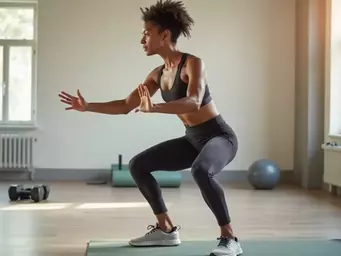Movement Science in Exercise Physiology
By Dr. Lena Schippert / Nov 10
What if you could enhance your physical capabilities and prevent injuries with just a few assessments? Understanding how to analyze your movement can be the key to a healthier, more active life. Dive into the world of biomechanics and discover the transformative potential of biomechanical assessments!
Biomechanical assessments are systematic evaluations to measure how our bodies move. They involve a range of tests and evaluations that examine body mechanics during various movements. Below are the three key areas of biomechanical assessments: To learn more about how biomechanics fits into a broader fitness context, check out Biophysics and Functional Fitness Explained.
Observing the way you walk to identify abnormalities. This helps in understanding movement patterns during locomotion.
Checking your body alignment in various positions to detect imbalances and misalignments.
Assessing basic movement patterns to find limitations and potential injury risks.
At Functional Fitness & Movement Science, we believe that understanding biomechanical assessments is key to improving movement quality. These assessments help us analyze how we move and identify any potential inefficiencies or limitations. By taking a closer look at our biomechanics, we can enhance our overall performance and well-being!
So, what exactly are biomechanical assessments? They involve a range of tests and evaluations that examine body mechanics during various movements. Whether you're an athlete looking to optimize your performance or someone wanting to prevent injuries, these assessments provide valuable insights into your movement patterns.
Biomechanical assessments are systematic evaluations designed to measure how our bodies move in different activities. They can include a variety of tests like gait analysis, posture assessments, and functional movement screenings. Each of these tests aims to pinpoint areas of strength and weakness, ultimately guiding us toward better movement practices. For a deeper dive into the significance of these assessments, explore how Biomechanics is Key to Functional Fitness.
Understanding the results from these assessments can empower you to make informed choices about your training regimen and daily activities. If you're curious about how your movement may be affecting your physical health, these assessments are a great place to start!
By evaluating our movement patterns, biomechanical assessments can significantly enhance our physical capabilities. They help us recognize inefficient movement strategies, which can lead to injuries over time. For instance, a simple adjustment in your squat form or running technique could dramatically reduce your risk of injury while improving performance.
It's essential to think of these assessments not just as tests, but as tools for lifelong improvement. Through regular evaluations, we can ensure that our movement remains fluid and effective.
At Functional Fitness & Movement Science, we emphasize that high-quality movement is critical for maintaining our health. Poor movement patterns can lead to overuse injuries, which can sideline you for weeks or even months. By focusing on movement quality, we can dramatically lower our chances of injury while enhancing our physical performance.
Implementing biomechanical assessments helps in cultivating awareness about how we move. This awareness can guide us to make better decisions in our workouts and daily activities, ultimately contributing to a healthier lifestyle.
Understanding the core principles of biomechanics is essential when conducting assessments. These principles include the following:
By applying these principles, we can gain deeper insights into our biomechanics and implement actionable strategies that enhance our movement quality. I encourage you to explore these concepts further, as they are fundamental to achieving optimal movement in our everyday lives!
I couldn't find a specific YouTube video titled "Top 10 Biomechanical Assessments to Improve Your Movement Patterns." However, I can suggest a video that might be relevant based on the available search results:We want to know your thoughts! How often do you engage in biomechanical assessments or check your movement quality? Share your experience with us:
When we talk about enhancing movement patterns, we really mean improving how our bodies move to promote long-term health and functionality. Regular biomechanical assessments are crucial for this journey. They not only highlight areas for improvement but also provide insights into your overall physical capabilities. By understanding your body better, you can make informed choices that lead to a healthier, more active life!
Some key benefits of integrating regular assessments into your routine include:
As we blend these assessments into our lives, remember that the goal is to cultivate a deeper connection with how you move. This journey toward enhanced movement patterns is not just about fixing problems; it’s about embracing a proactive approach to your health!
So, what exactly are the benefits of engaging in these assessments regularly? First and foremost, they provide a baseline for your movement quality. By comparing results over time, you can clearly see your progress and make adjustments as needed. This ongoing evaluation can significantly boost your motivation and commitment to maintaining a functional lifestyle.
Additionally, regular assessments can help in:
This holistic view of your movement quality not only enhances your performance in physical activities but also enriches your daily life!
While professional assessments are invaluable, incorporating home-based evaluations can extend the benefits of expert guidance. Simple exercises and self-assessments can help reinforce the principles learned during professional evaluations. Tools like video analysis or movement tracking apps can enhance your understanding of your movement patterns. Understanding potential pitfalls is key to avoiding issues, such as those discussed in Biomechanics of Functional Fitness Injuries.
Here are a few home-based assessments to consider:
By combining expert insights with your self-assessments, you create a comprehensive approach to enhancing your movement quality. Remember, the goal is to stay engaged and informed about your body’s capabilities!
Feedback from your biomechanical assessments is a powerful tool for achieving long-term success. Whether you’re looking to enhance athletic performance or simply maintain your functional capabilities, understanding this feedback is critical. It allows for tailored exercise programs that address specific needs, ultimately leading to sustainable improvements.
To make the most of this feedback, consider:
By actively engaging with your biomechanical feedback, you’re better equipped to make informed decisions that support your movement health for years to come!
Here is a quick recap of the important points discussed in the article:



 Movement Science in Exercise Physiology
In the world of fitness, understanding the intricate relationship between how we move and the scienc
Movement Science in Exercise Physiology
In the world of fitness, understanding the intricate relationship between how we move and the scienc
 Fixing Poor Form for Safety
Have you ever felt sore in unexpected places after a workout? This often points to poor form during
Fixing Poor Form for Safety
Have you ever felt sore in unexpected places after a workout? This often points to poor form during
 Injury Prevention Strategies for Lifelong Activity
What if the secret to a longer, healthier life lies in understanding how we move? By focusing on inj
Injury Prevention Strategies for Lifelong Activity
What if the secret to a longer, healthier life lies in understanding how we move? By focusing on inj